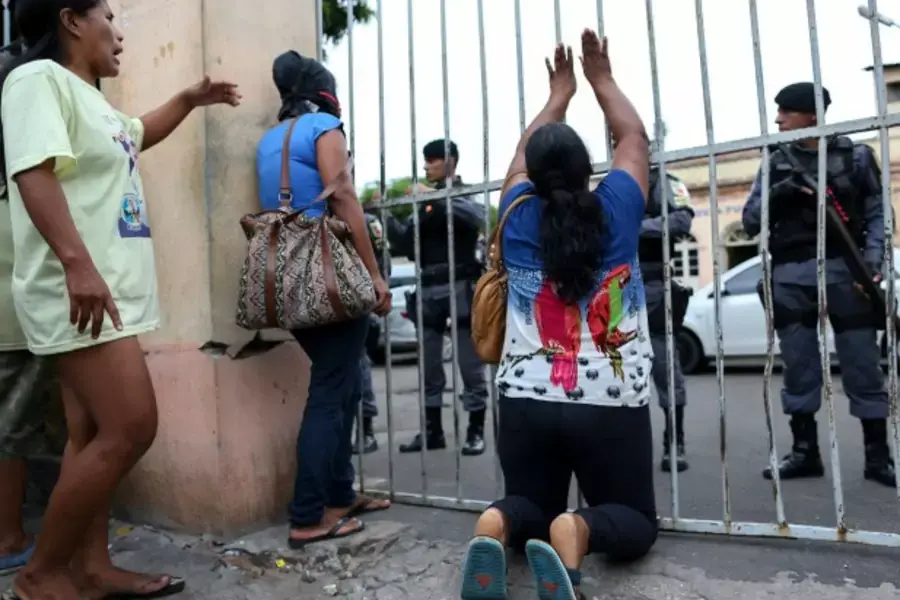The Even Scarier Thing About Brazil’s Prison Violence

More on:
Prison violence has taken the lives of more than one hundred Brazilian prisoners since the beginning of the year. While the recent killings have been gruesome and especially numerous, they are a continuation of a long-standing pattern of savage prison violence that has developed its own macabre logic of control. Scarier still than the calculated horror of the past week’s violence, though, is the possibility that this prison violence may contribute to the consolidation of a particularly virulent form of criminal organization that threatens the rule of law in Brazil and its neighbors.
Like many other countries in the hemisphere, Brazil responded to an upsurge of violence after the return to democracy with a get-tough policing strategy. The prison population nationwide has more than quintupled since 1990. Brazil imprisons more of its population per capita than any other country in South America (307 prisoners per 100,000 inhabitants), and has the fourth largest prison population in the world. Conditions in the prisons are abominable, with many facilities outsourced to profit-oriented contractors, who often abdicate internal control to inmates. Government investment in building new prison capacity has been a low priority: occupancy rates are officially nearly 60 percent higher than capacity, and pre-trial detainees account for more than one third of all prisoners. These abysmal conditions are fertile ground for prison gangs who exploit the vulnerable populations behind bars.
The most perverse development of the past generation in Brazil, though, has been criminal organizations’ increasing recognition that dominance of prison populations also gives them enormous control over criminal activity outside prison gates. This logic works as follows: prison gangs can extort individuals on the street because they hold their friends and family hostage in jail. Further, because criminals currently on the street are likely to spend time in jail at some point in their careers (where they will be vulnerable to gang violence), they have incentives to either join those gangs or pay tribute to them. The predictable result, as David Skarbek demonstrated with reference to the Mexican Mafia prison gang in Southern California, is that prison gangs have control not only within prisons, but also – by virtue of their lock on vulnerable populations behind bars – enormous influence on the streets.
Given the scale of Brazil’s prison gangs, the consequences for the rule of law are significant. In May 2006, the Primeiro Comando da Capital (PCC) – one of the prison gangs currently vying for power in Brazil’s northern states – responded to the planned transfer of some of its leaders in São Paulo state by engaging in a series of targeted attacks outside the prison system. At least 140 people were killed in the first round of attacks, and the industrial metropolis of São Paulo shut down as police and the PCC battled. The very idea that the PCC could confront the state directly is frightening. More horrific still is the fact that the PCC is now battling other prison gangs for control of prisons in the northern states of Brazil, far from its original home base in the southeast of Brazil, as well as challenging the Comando Vermelho on its home turf in Rio de Janeiro, which the PCC has traditionally treated as off-limits.
The PCC has already shown that it is capable of terrific exploits when left unchecked. The gang is said to have been behind the theatrical and record-breaking 2005 heist of $70 million from the Central Bank regional headquarters in Fortaleza. It has engaged in widespread corruption of public officials. It is believed to be active across national borders, with an active presence in Paraguay and interest in developing ties along Brazil’s northwestern border to Colombia, Bolivia, and Peru. It is active not only in illicit activities, like drug trafficking, but is also believed to have moved into the licit economy. And it now appears to have broken its longstanding armistice with the Comando Vermelho, in a move that may be calculated to ensure it can control northern drug routes.
The short-term implications are already clear—prison violence will probably continue to percolate until the gangs establish a new pecking order. The longer term worry is that the battle for dominance of the prisons could result in an even more powerful, nationwide criminal organization with enhanced capacity to organize effectively, act with impunity, corrupt at will, and when necessary, confront the Brazilian state.
More on:
 Online Store
Online Store
